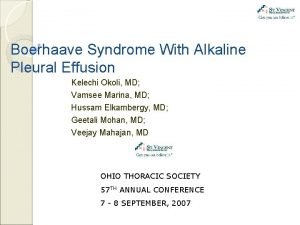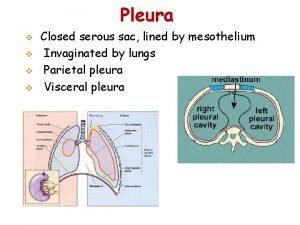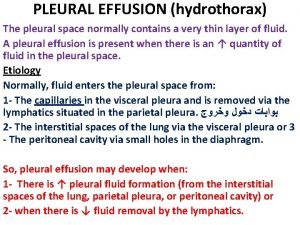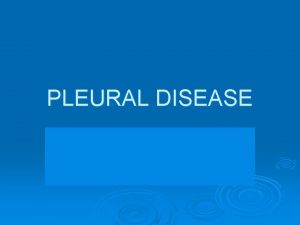C L I P S Evaluation Pleural Effusions


- Slides: 2

C. L. I. P. S. Evaluation Pleural Effusions How Common § Affects 1. 5 million people each year-U. S. Causes § Heart failure-transudate § Pneumonia-exudate § Cancer-exudate § PE can be either transudate or exudate How do they usually present (history)? § Asymptomatic, dyspnea, cough, pleuritic chest pain § Differentiate cardiac (heart failure, pericarditis) from pulmonary (pneumonia, PE, malignancy)and GI (Cirrhosis, pancreatitis) Physical exam findings § Auscultation-decreased breath sounds § Percussion-dullness § Palpation-decreased tactile fremitus Radiology § CXR-Need 50 ml to see meniscus on lateral, 200 ml to see on AP § Get lateral decub (both right and left) can be helpful USN§ Anechoic fluid collection above the diaphragm § Loss of mirroring (lung usually looks like liver in normal) § Extension of the spine sign above diaphragm Patients with effusions from heart failure DO NOT need a Thoracentesis

C. L. I. P. S. Pleural Effusions Thoracentesis • Indications-DX- unexplained effusion, empyema Tx- relieve dyspnea, improve oxygenation • Contraindications-uncooperative pt, skin infection at site, ruptured diaphragm. • OK to perform if platelets above 25 k, INR below 3, bleeding risk 0. 4% • Consider US guided • Never take more than 1. 5 L Never use Evacuated container • Stop procedure if aspirate air, increasing dyspnea, chest pain or cough. Laboratory • CBC with diff • Protein, Alb LDH, Glucose • Culture and Gram stain- Inoculate culture bottles at bedside. Lights criteria of exudate • ratio of pleural fluid protein to serum protein > 0. 5 • ratio of pleural fluid LDH to serum LDH > 0. 6 • pleural fluid LDH level > 2/3 upper limit of normal for serum LDH Transudates § Increase hydrostatic pressure of decreased osmotic pressure-CHF Nephrotic syndrome, cirrhosis Exudates • Increased capillary permeability, impaired fluid resorption- Empyema, Ca, viral/bacterial infections. Bloody • less than 1% of pt HCT- no worries. 1 -20% PE, cancer or trauma No need for CXR after procedure unless pt has increasing SOB.



